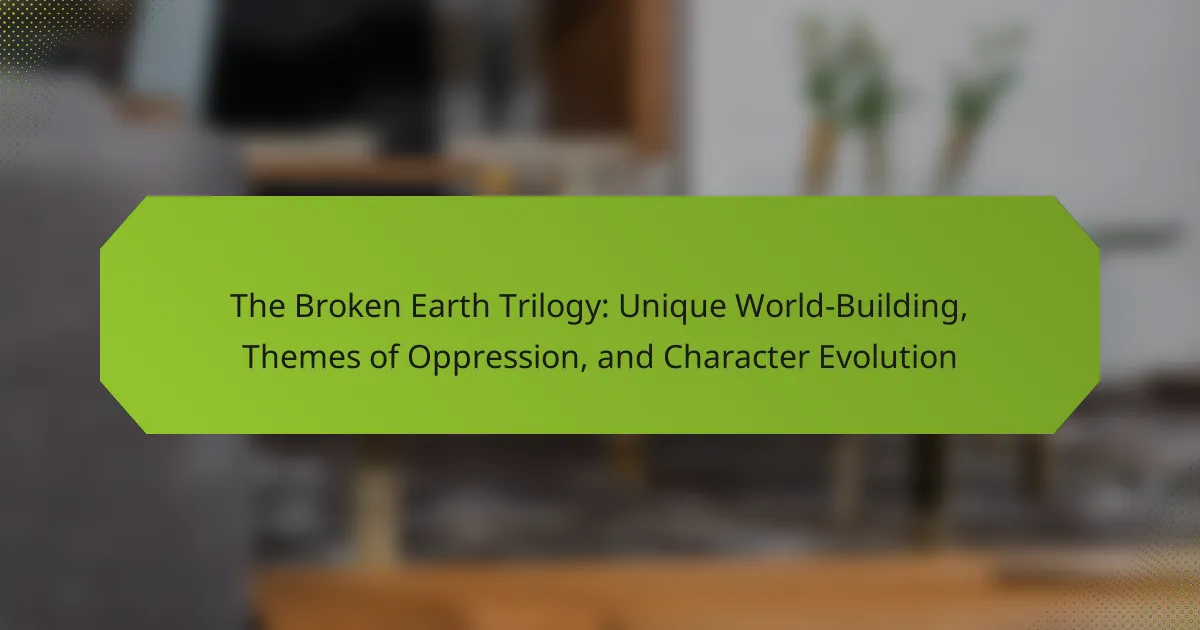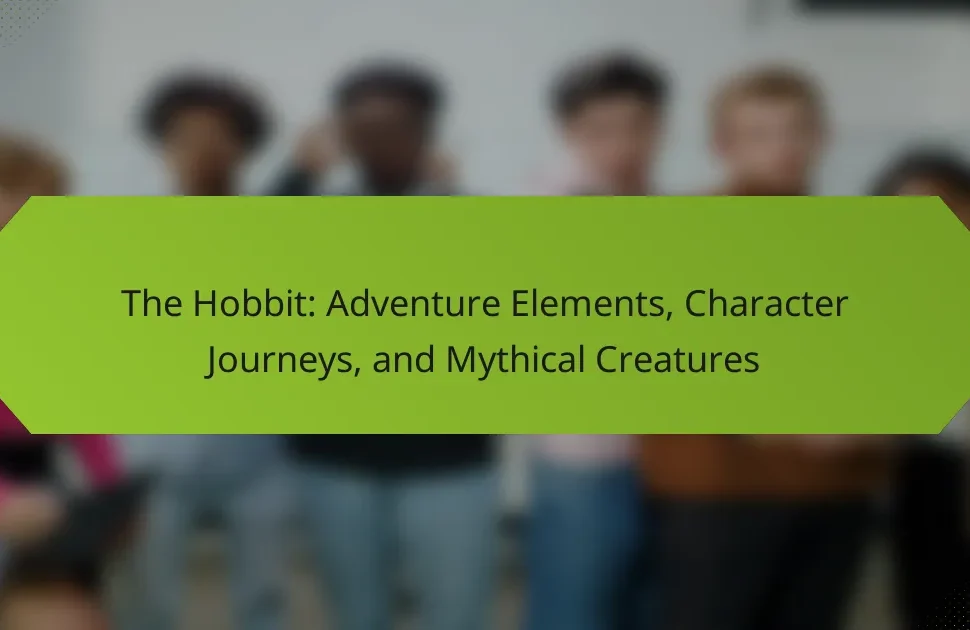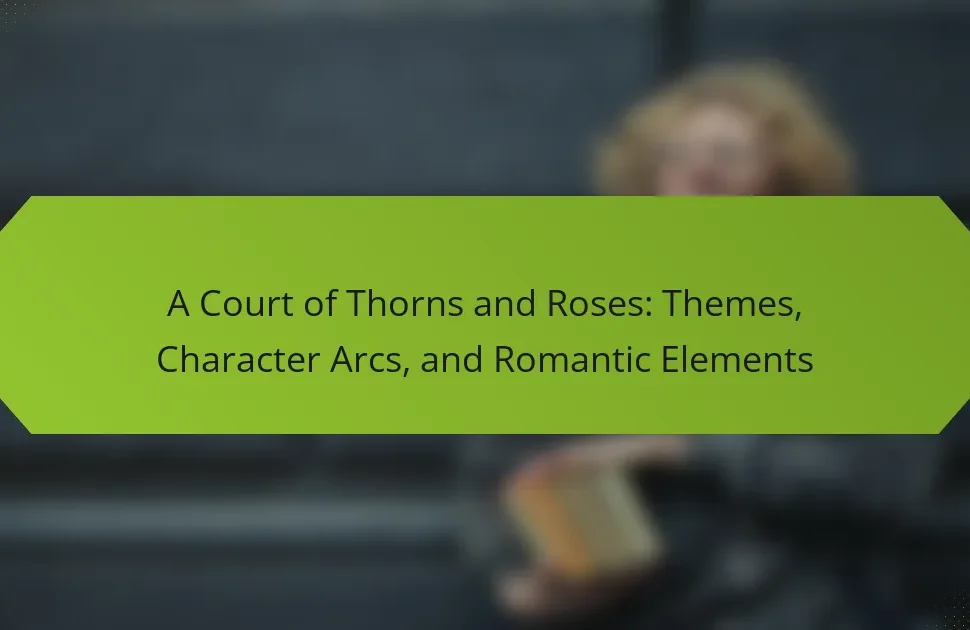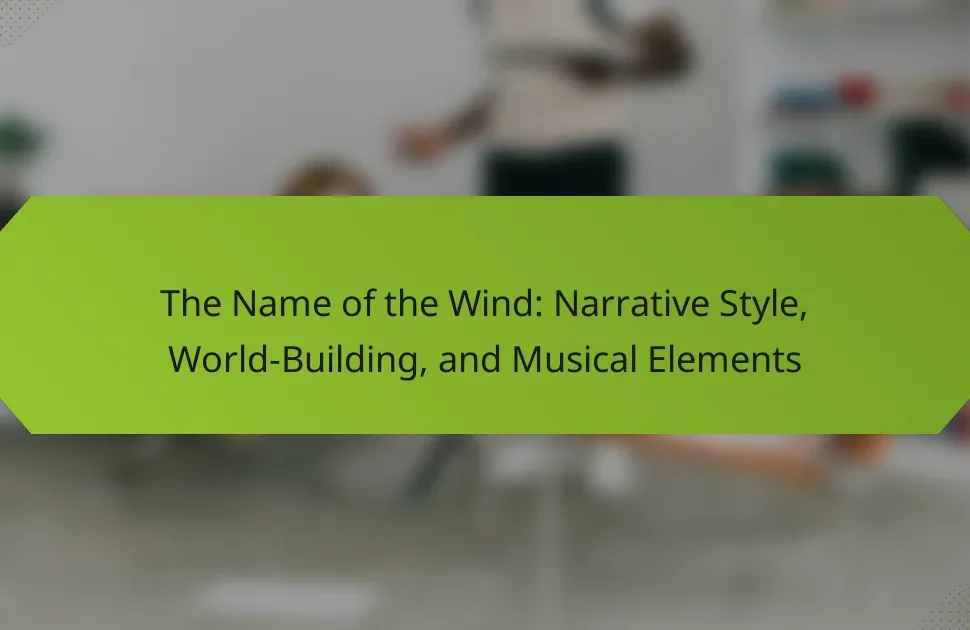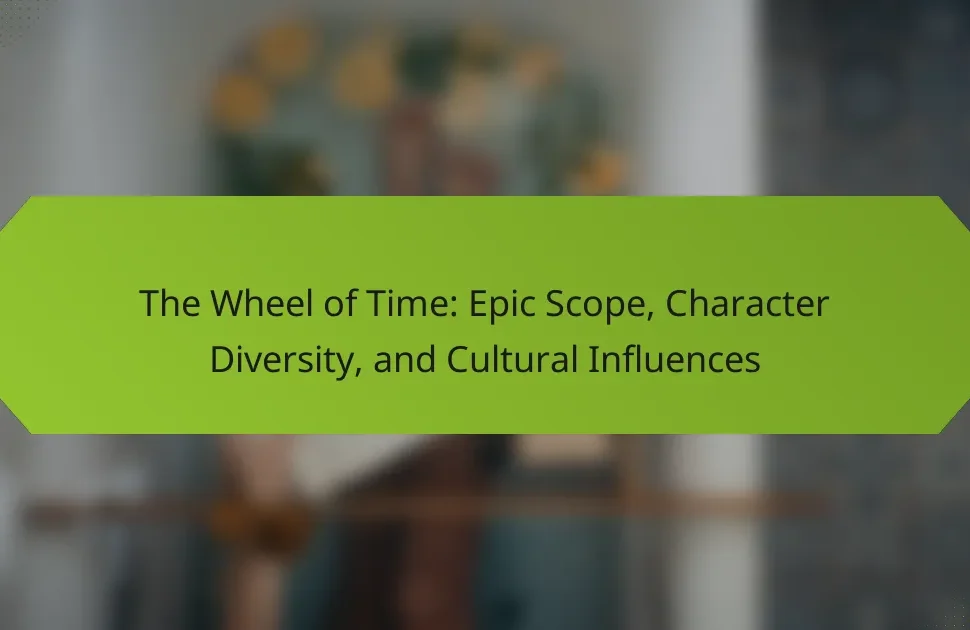The Broken Earth Trilogy captivates readers with its intricate world-building, exploring themes of oppression and character evolution. It features a unique magic system centered on orogeny, which influences societal hierarchies and personal struggles. The narrative delves into systemic injustice and resilience, showcasing profound character transformations against a backdrop of environmental challenges. Through innovative storytelling techniques, the trilogy highlights the complexities of power dynamics and the human spirit’s capacity for resistance.
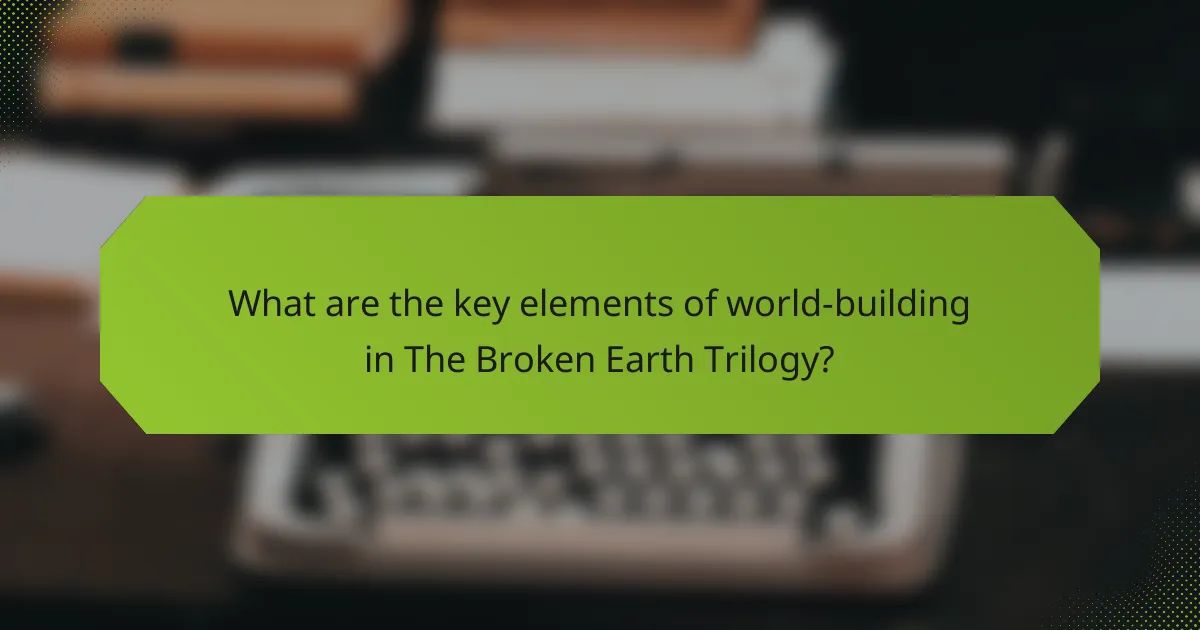
What are the key elements of world-building in The Broken Earth Trilogy?
The key elements of world-building in The Broken Earth Trilogy include a complex magic system, societal hierarchies, and environmental challenges. The trilogy features orogeny as a unique attribute, where certain individuals can manipulate geological forces, creating both awe and fear. This magic system deeply influences societal structures, reinforcing themes of oppression as orogenes face systemic discrimination. The harsh, unstable environment serves as a backdrop, shaping character evolution and interpersonal dynamics, ultimately reflecting broader themes of survival and resilience.
How does the setting influence character development?
The setting profoundly influences character development in “The Broken Earth Trilogy” by shaping identities and motivations. The oppressive environment of the Stillness forces characters to adapt, revealing their strengths and vulnerabilities. Characters like Essun and Syenite evolve in response to societal expectations and personal traumas, illustrating how external conditions drive internal growth. The unique world-building enhances themes of oppression, making character evolution a reflection of their struggles against systemic forces.
What role does the geology play in the narrative?
Geology plays a crucial role in “The Broken Earth Trilogy” by shaping the environment and influencing societal structures. The trilogy’s setting features a planet plagued by seismic activity, which drives the oppression of orogenes, individuals with the ability to control geological forces. This unique attribute of the world creates tension and conflict, as the societal perception of orogenes as threats reflects broader themes of fear and discrimination. The harsh geological conditions serve as a backdrop for character evolution, highlighting resilience and the struggle against systemic oppression. The narrative intertwines the physical landscape with the characters’ journeys, emphasizing how geology informs identity and power dynamics.
Which cultural aspects are depicted in the trilogy?
The trilogy depicts various cultural aspects, including themes of oppression, resilience, and societal structures. It explores the impact of systemic discrimination on marginalized communities, particularly through the lens of the orogenes. The narrative illustrates how cultural identity shapes individual experiences and collective resistance against authority. Additionally, it reflects on the complexities of power dynamics within societies and the role of history in shaping cultural narratives.
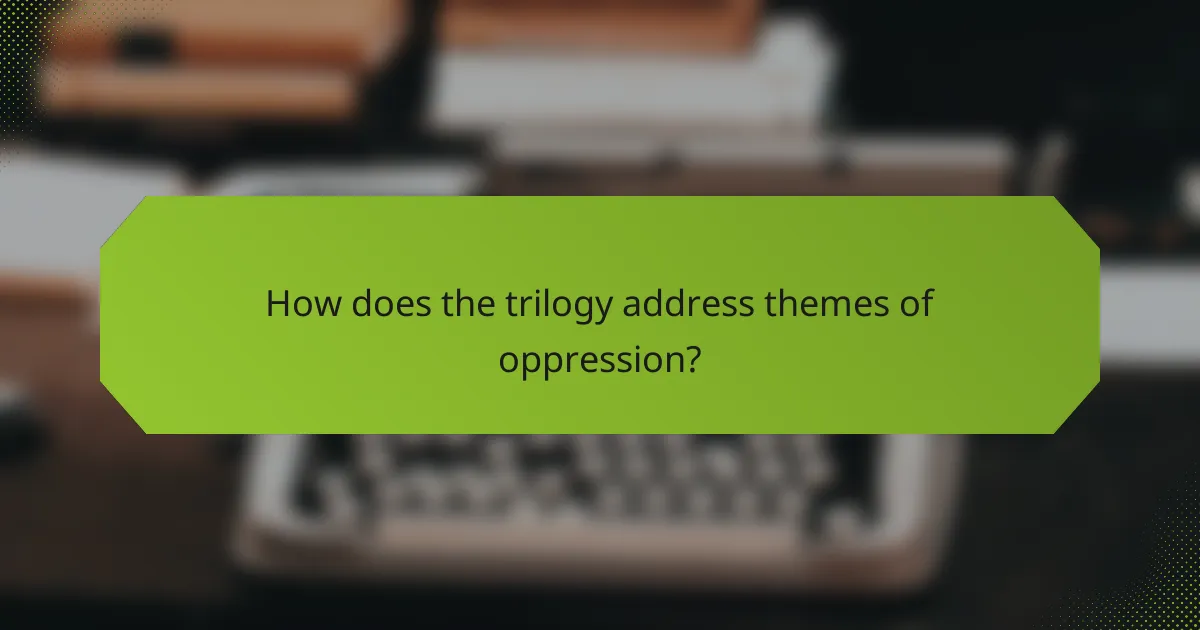
How does the trilogy address themes of oppression?
The trilogy addresses themes of oppression through its portrayal of systemic injustice and individual struggles. The characters navigate a world where their abilities are both feared and exploited, reflecting real-world societal hierarchies. The unique attribute of the trilogy is its focus on marginalized groups, specifically the orogenes, who face discrimination and violence. This narrative framework allows for an exploration of power dynamics, resilience, and the quest for identity amidst oppression. As a result, readers gain insight into the complexities of societal structures and the human spirit’s capacity for resistance.
What forms of societal control are illustrated?
The Broken Earth Trilogy illustrates various forms of societal control, including systemic oppression, institutionalized discrimination, and cultural hegemony. These mechanisms manifest through the subjugation of orogenes, who face societal rejection and exploitation. The ruling class employs fear and misinformation to maintain power, ensuring compliance and reinforcing social hierarchies. Additionally, the trilogy explores how these controls affect individual identity and community dynamics, showcasing the struggle against dehumanization.
How do characters respond to systemic injustice?
Characters in “The Broken Earth Trilogy” respond to systemic injustice through resilience and adaptation. They confront oppression, often demonstrating profound emotional and psychological evolution. For instance, Essun embodies the struggle against societal norms while navigating personal loss. Syenite’s journey reflects the quest for autonomy within a repressive system. These character arcs illustrate how individuals can challenge and transform their circumstances despite overwhelming obstacles. The trilogy emphasizes that systemic injustice shapes identities and relationships, ultimately fostering a deeper understanding of power dynamics and resistance.
Which historical parallels can be drawn from the story?
The Broken Earth Trilogy reflects historical parallels with themes of oppression and survival. The experiences of the oppressed orogenes mirror real-world struggles against systemic discrimination. For example, the societal rejection of orogenes highlights the consequences of fear and misunderstanding, akin to historical injustices faced by marginalized groups. Additionally, the trilogy’s exploration of power dynamics resonates with colonial histories, showcasing how dominant societies exploit and dehumanize the vulnerable. The evolution of characters like Essun emphasizes resilience, drawing parallels to historical figures who fought for justice and equality despite overwhelming odds.
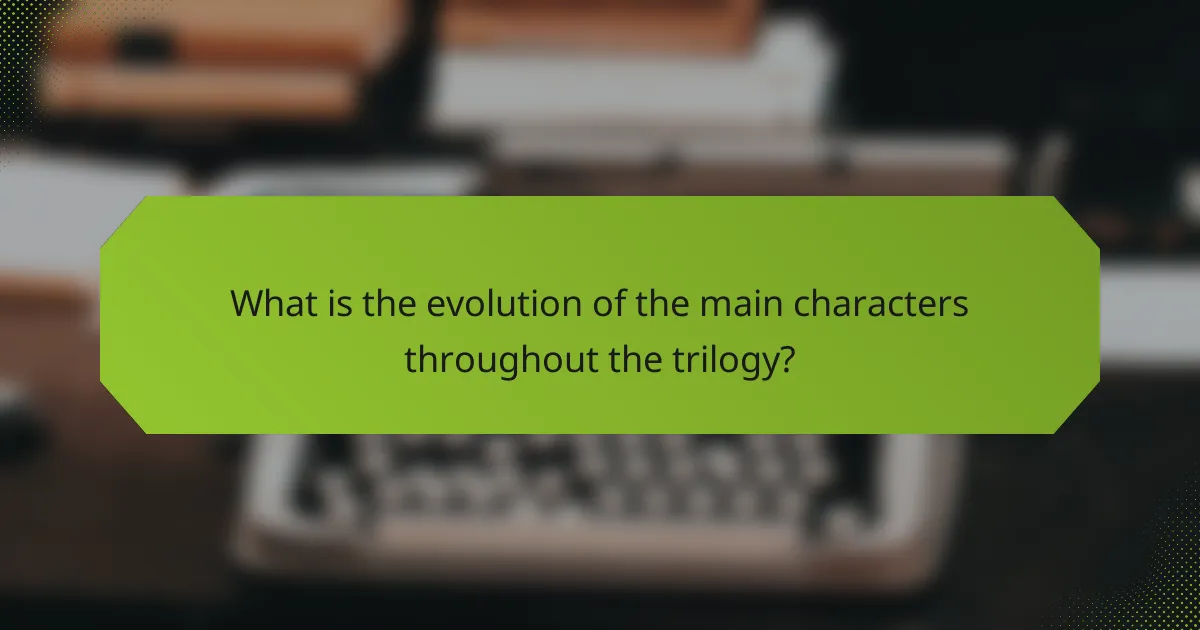
What is the evolution of the main characters throughout the trilogy?
The main characters in “The Broken Earth Trilogy” undergo profound transformations driven by personal struggles and societal oppression. Essun evolves from a mother seeking her daughter to a powerful figure confronting her identity and abilities. Syenite transitions from a tool of the oppressive system to an agent of change, embracing her unique powers. Alabaster’s journey reflects the burden of knowledge and sacrifice, as he navigates his role in the broader conflict. Each character’s evolution highlights themes of resilience, identity, and the fight against systemic injustice.
How do personal struggles reflect larger societal issues?
Personal struggles in “The Broken Earth Trilogy” symbolize broader societal issues like oppression and systemic inequality. The trilogy’s unique world-building portrays a society divided by fear and prejudice against the orogenes, individuals with the ability to manipulate the earth. This reflects real-world themes of marginalization and the fight for acceptance.
Character evolution in the trilogy illustrates personal growth against societal constraints. Essun, the protagonist, embodies resilience amidst a world that dehumanizes her. Her journey highlights the impact of personal trauma on collective experiences.
The trilogy’s themes resonate with historical and contemporary issues, such as racism and social injustice. By examining individual struggles, the narrative critiques societal structures that perpetuate oppression. The intricate world-building serves as a metaphor for the complexities of human relationships and societal dynamics.
What are the transformative experiences of key characters?
Key characters in “The Broken Earth Trilogy” undergo profound transformations shaped by oppression and personal struggles. Essun evolves from a mother seeking her kidnapped daughter to a powerful orogene, embodying resilience. Syenite transitions from a coerced breeding tool to a figure of rebellion, embracing her identity. Alabaster’s journey from a mentor to a tragic hero highlights the burden of knowledge and sacrifice. These experiences reflect the trilogy’s themes of survival, identity, and the fight against systemic oppression.
Which character arcs are most significant in conveying the trilogy’s themes?
The most significant character arcs in “The Broken Earth Trilogy” revolve around Essun, Syenite, and Alabaster, each embodying themes of oppression and resilience. Essun’s journey highlights the struggle against societal constraints, while Syenite’s evolution showcases the quest for identity amidst systemic control. Alabaster’s arc serves as a poignant reflection on sacrifice and the burden of power. Together, these characters illustrate the trilogy’s exploration of survival and the complexities of human relationships under duress.

How does the trilogy portray the intersection of power and vulnerability?
The trilogy illustrates the intersection of power and vulnerability through its exploration of oppression and resilience. Characters navigate a world where societal structures enforce dominance while simultaneously revealing their personal vulnerabilities. The unique ability of orogeny symbolizes both power and the fear it instills in others. This duality highlights how those in power often exploit vulnerabilities, while the oppressed demonstrate strength in their resistance. The narrative emphasizes that true power lies not only in control but in the capacity to empathize with the vulnerable.
What unique character traits highlight the struggle for agency?
Unique character traits that highlight the struggle for agency in “The Broken Earth Trilogy” include resilience, adaptability, and defiance. These traits manifest as characters navigate oppressive systems and seek autonomy. For example, Essun’s resilience drives her to protect her children despite immense personal loss. Similarly, Syenite’s adaptability allows her to confront societal expectations, challenging the status quo. Defiance is evident in characters who actively resist their roles, showcasing the complex interplay between power and personal agency.
How do relationships evolve under oppressive circumstances?
Relationships in oppressive circumstances often become complex and multifaceted. In “The Broken Earth Trilogy,” characters navigate power dynamics and survival, which profoundly impact their connections. The oppressive environment fosters resilience, forcing individuals to rely on each other for emotional and physical support. This reliance can lead to deep bonds or intense conflicts, as trust becomes a critical currency.
The evolution of relationships is marked by shared trauma and collective struggle. Characters like Essun and her family exemplify how oppression can strain familial ties, yet also strengthen them through shared goals. The unique attribute of their circumstances, such as societal collapse and systemic violence, creates a backdrop where relationships are tested and transformed.
As a result, characters often find themselves redefining loyalty and love. The rare instances of solidarity among oppressed individuals highlight the potential for empathy and understanding in dire situations. This theme underscores the narrative, illustrating that even in the darkest times, human connections can evolve into sources of strength and hope.
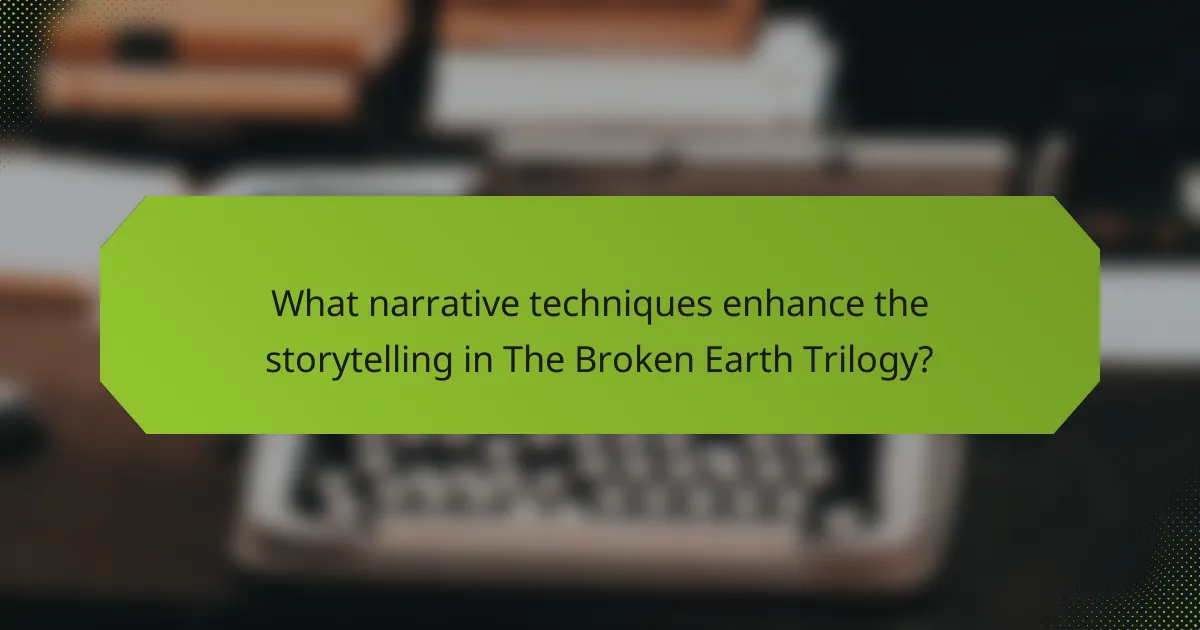
What narrative techniques enhance the storytelling in The Broken Earth Trilogy?
The Broken Earth Trilogy employs narrative techniques that deepen its world-building, highlight themes of oppression, and illustrate character evolution. Techniques such as non-linear storytelling, multiple perspectives, and rich symbolism enhance the complexity of the narrative. Non-linear storytelling allows readers to piece together the past and present, revealing how historical oppression shapes characters’ identities. Multiple perspectives provide insights into various experiences of oppression, fostering empathy and understanding. Rich symbolism, particularly in the use of earth and geological imagery, reinforces themes of resilience and transformation throughout the trilogy. These techniques collectively create a layered and immersive reading experience.
How does the use of multiple perspectives affect reader engagement?
The use of multiple perspectives enhances reader engagement by providing diverse viewpoints and deeper emotional connections. In “The Broken Earth Trilogy,” this technique allows readers to experience the complex themes of oppression and character evolution from various angles. Each character’s unique perspective reveals their struggles and motivations, fostering empathy and investment in their journeys. This narrative style enriches world-building, making the setting and its societal issues more relatable and compelling. By presenting contrasting viewpoints, the trilogy encourages critical thinking and reflection on the broader themes, ultimately deepening reader engagement.
Which literary devices are employed to deepen thematic exploration?
The Broken Earth Trilogy employs various literary devices to deepen thematic exploration, including symbolism, foreshadowing, and allegory. Symbolism enhances the themes of oppression and resilience, as seen through the use of the obelisks representing power and control. Foreshadowing builds tension and highlights the inevitability of conflict, reflecting the characters’ struggles. Allegory serves to critique societal structures, making the narrative a profound commentary on systemic injustice. These devices collectively enrich the reader’s understanding of complex themes and character evolution.
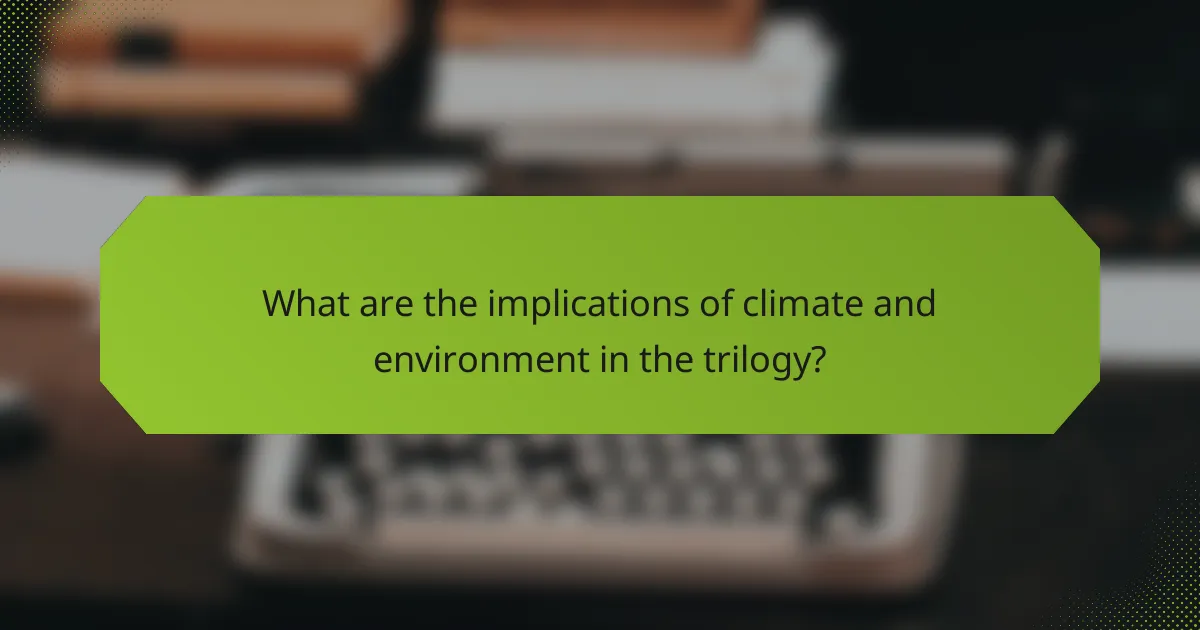
What are the implications of climate and environment in the trilogy?
The implications of climate and environment in “The Broken Earth Trilogy” are profound and multifaceted. The trilogy’s world is marked by catastrophic geological instability, which shapes societal structures and individual fates. The oppressive environment reflects themes of survival and resilience, as characters navigate a world where natural disasters dictate power dynamics.
Geological events, such as seismic activity, serve as a backdrop to the characters’ struggles, influencing their evolution and interactions. This unique setting underscores the trilogy’s exploration of oppression, as marginalized groups are often most affected by environmental changes. The climate acts as both a literal and metaphorical force, emphasizing the interconnectedness of environment and human experience.
Ultimately, the trilogy illustrates how climate and environment are not just backdrops but active participants in the narrative, shaping the characters’ journeys and the societal hierarchies within the world.
How does environmental degradation shape the plot?
Environmental degradation profoundly influences the plot of “The Broken Earth Trilogy” by establishing a backdrop of oppression and survival. The series depicts a world ravaged by environmental collapse, where seismic activity and climate change create a harsh landscape. This setting shapes character motivations and societal structures, highlighting themes of power and subjugation. The oppressive environment serves as a catalyst for character evolution, pushing individuals to confront their identities and roles within a fractured society. As characters navigate this challenging world, their struggles reflect broader issues of environmental justice and resilience.
What messages about sustainability can be inferred?
The Broken Earth Trilogy conveys strong messages about sustainability through its depiction of environmental degradation and societal collapse. The narrative emphasizes the consequences of exploiting natural resources, urging readers to consider long-term ecological impacts.
The trilogy illustrates the importance of harmony between humanity and the environment. Characters evolve through their understanding of sustainability, highlighting the need for collective responsibility. This evolution reflects a unique attribute of the series, where personal growth aligns with broader themes of ecological stewardship.
Additionally, the oppressive systems in the story serve as a rare attribute, showcasing how power dynamics can hinder sustainable practices. The struggle against these systems parallels real-world challenges, reinforcing the urgency for sustainable solutions in contemporary society.
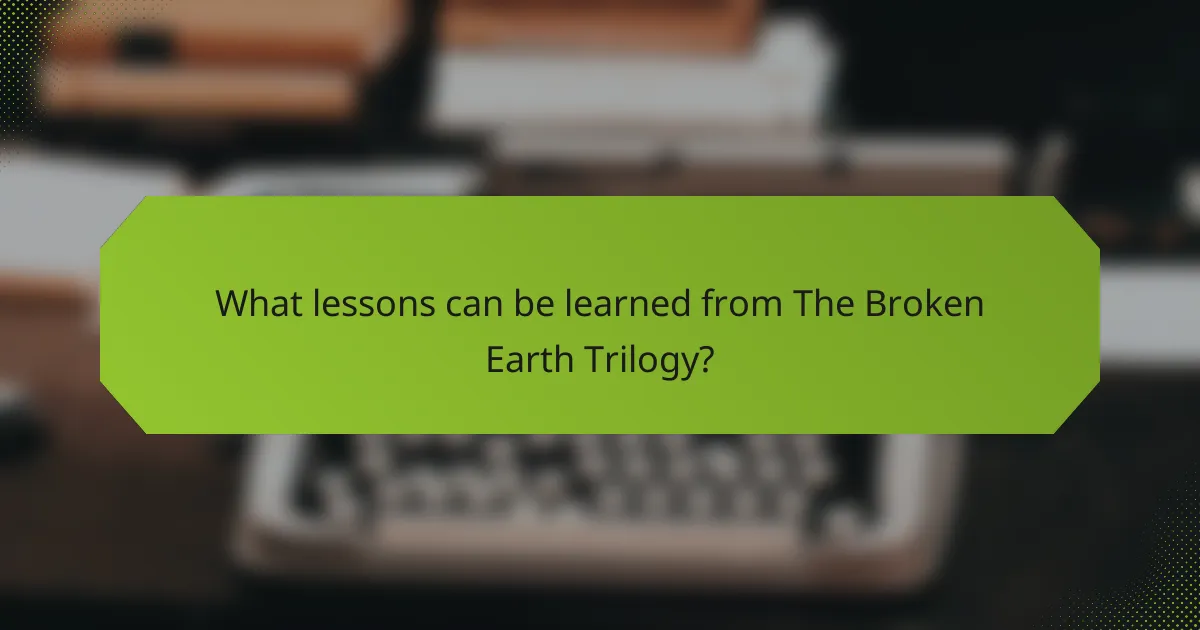
What lessons can be learned from The Broken Earth Trilogy?
The Broken Earth Trilogy offers profound lessons on resilience, identity, and societal structures. It emphasizes the impact of oppression on individuals and communities. The trilogy’s unique world-building illustrates the complexities of power dynamics and survival. Character evolution showcases personal growth amidst adversity, highlighting the importance of agency and connection.
What best practices can readers apply to understand complex narratives?
Readers can apply several best practices to understand complex narratives effectively. First, engage with the text actively by taking notes on key themes and character developments. This enhances retention and comprehension. Second, identify the unique world-building elements, such as societal structures and cultural nuances, which provide context to the narrative’s conflicts. Third, analyze the themes of oppression and character evolution to grasp the underlying messages. Finally, discuss the narrative with others to gain diverse perspectives, enriching the understanding of intricate plotlines and character arcs.
Which common mistakes should be avoided when interpreting themes?
Avoiding common mistakes in interpreting themes enhances understanding of “The Broken Earth Trilogy.” Key mistakes include oversimplifying themes, ignoring character development, and neglecting the socio-political context. Misreading the significance of oppression in the narrative diminishes the impact of the world-building. Additionally, failing to recognize the evolution of characters can lead to a superficial analysis. Lastly, overlooking the unique attributes of the trilogy, such as its intricate power dynamics, can result in a flawed interpretation.
